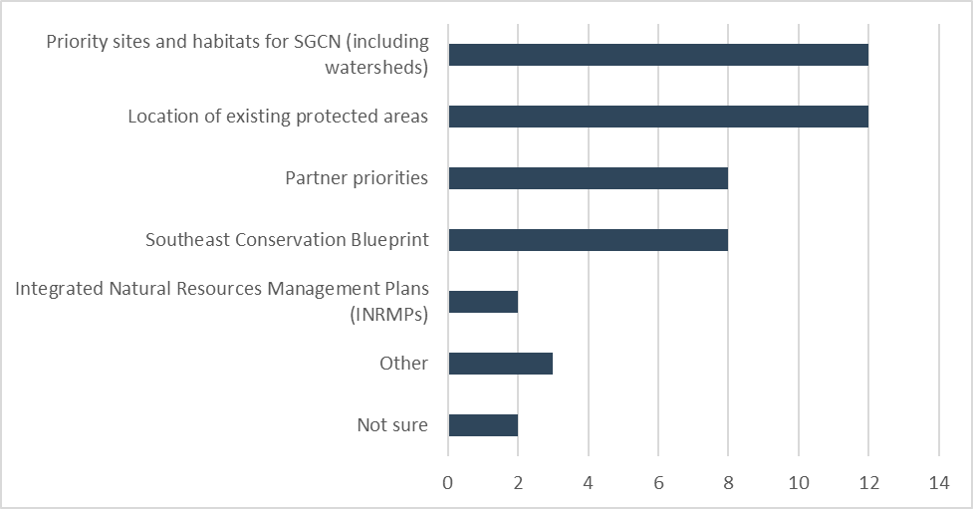The SWAP survey says...

One of the aims of SECAS is to clear barriers to conservation actions across jurisdictional boundaries. This is why SECAS staff are working with the SEAFWA Wildlife Diversity Committee (WDC) to help develop potential opportunities to align State Wildlife Action Plans (SWAPs) in the Southeast. This follows guidance and recommendations from the Association of Fish and Wildlife Agencies (AFWA) President’s Task Force on Shared Science & Landscape Conservation Priorities and the AFWA State Wildlife Action Plan & Landscape Conservation Work Group. The WDC, the AWFA Task Force, and the AFWA Work Group recognize that aligning SWAPs is an efficient and effective way to support cross-jurisdictional conservation actions and sustain Species of Greatest Conservation Need (SGCN).
The SEAFWA WDC established a subcommittee to help identify potential recommendations for Southeastern states to align their SWAPs. As I mentioned in my previous blog, the subcommittee sent a survey to each SWAP coordinator in the Southeast region (15 states, Puerto Rico, and the U.S. Virgin Islands). The survey sought to elicit information about how each state or territory (the states) approaches their SWAP, what tools they use, and what elements of SWAP revision they find most challenging.
And the results are in!
The survey found that most states do not consider any major components of revising their SWAP to be easy to accomplish. This is likely no surprise to SWAP coordinators. However, some components of SWAP revision are more challenging than others. The majority of states reported the following components as the most challenging parts of their SWAP revision:
- Identifying or updating SGCN
- Incorporating climate change information
- Identifying threats and conservation actions
- Developing habitat classifications
The survey also found several areas of consensus and opportunities for states to work together. For example, 13 states plan to incorporate plants as SGCN in the next revision cycle and at least 12 states will include Conservation Opportunity Areas (COAs). The states also share agreement that aligning SWAPs is important and there is an interest in developing a template that provides guidance on how to populate chapters and address the eight required elements of a SWAP.
Also, although the states have used different methods for developing their SGCN, states plan to use several common resources, like federally listed species and global and state rarity ranks. This information is helpful in thinking about potential ways the states could standardize their SGCN lists. For example, the NatureServe Ranking Calculator may be a tool that all states could use (six states are currently using this tool) to update their SGCN in the next SWAP revision.
Another area where states are using similar resources is in developing Conservation Opportunity Areas (COAs). Almost all the states plan to use priority sites and habitats for SGCNs and existing protected areas. Eight states indicated that they plan to use partner priorities and the Southeast Conservation Blueprint, the primary product of SECAS, to help identify COAs.
In summary, while there was no strong consensus about what the states expect to be easy to accomplish for their SWAP revisions, there are opportunities for the states to share lessons learned. For example, while most states consider integrating climate change information as a big challenge, one state reported that they expected it to be relatively easy. This could be an opportunity for that state to share their approach and lessons learned to help other states that consider it more of a challenge.
Also, while states may use common resources and tools, how they use those resources and their experience accessing and using that information may be significantly different. Knowing what types of information states may use in their revisions provides partners an opportunity to consider the best ways to deliver information and resources to the states. For example, Blueprint user support staff are discussing how to best provide consistent products that draw on similar approaches to help interested states develop their COAs.
Currently, the WDC subcommittee is coordinating monthly meetings focused on special topics identified from the survey. This subcommittee has already hosted one working group meeting to talk about SGCN, including ways to improve the selection process and sharing experiences with state representatives. The subcommittee will present recommendations to the SEAFWA WDC in the spring of 2022.
To get involved with the WDC subcommittee’s working group meetings, reach out to Allison Fowler. For more information about the results of the survey or for help using the Southeast Blueprint, contact Louise Vaughn. If you’d like more details, the raw results of the full survey are available here. A more complete final report will be available on the SECAS website next month.